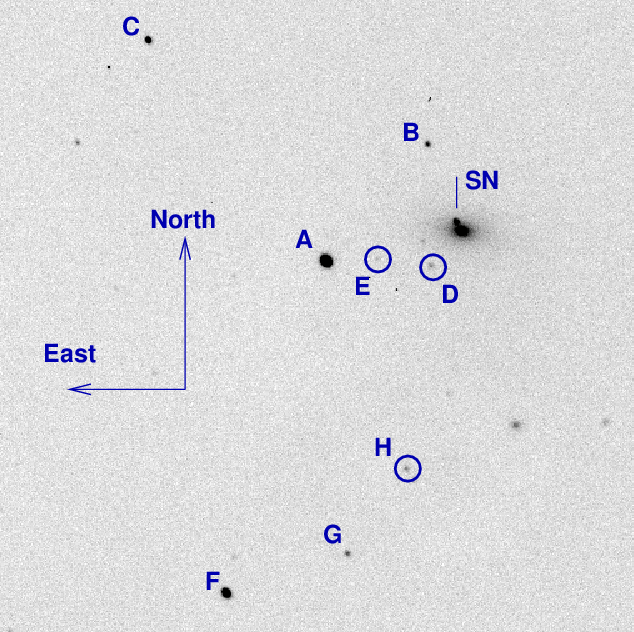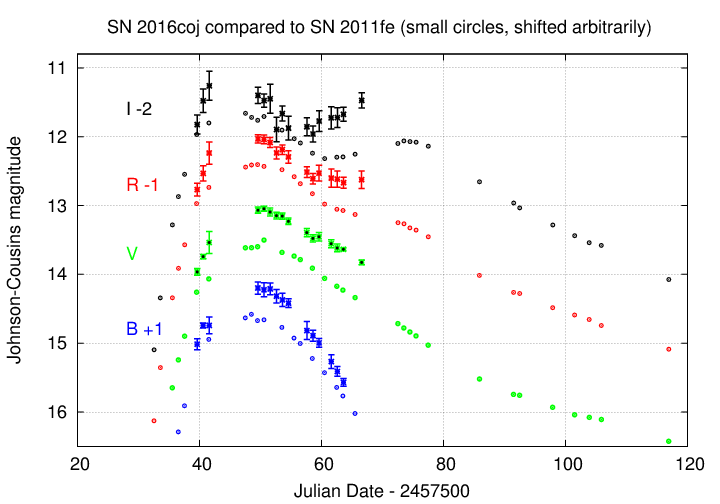
On the night of Jun 26/27, 2016, I observed SN 2016coj in NGC4125 through thick clouds. I was able to extract some noisy measurements in VRI, but not in B.
The main setup was:
Notes from the night
SN 2016coj is a Type Ia supernova in the relatively nearby galaxy NGC4125. It was discovered by the KAIT group some time before maximum light:
NGC 4125 RA = 12:08:05.7 Dec = +65:10:30 (J2000)

The AAVSO sequence team kindly provided photometry for stars near this object. You can see their full photometric sequence on their website. Below, I show only the members of that sequence which fall into my very small field of view -- taken from AAVSO sequence X16266F.
letter B sigB V sigV R sigR I sigI ------------------------------------------------------------------------ B 15.198 0.086 14.133 0.052 13.627 0.116 13.155 0.156 C 13.317 0.093 12.673 0.058 12.316 0.121 11.980 0.161 -------------------------------------------------------------------------
On this night, I took two series of 30-second dark frames: one set at the start of the run, and one set at the end, about 2 hours later. The CCD-TEMP keyword in the FITS header indicated a constant temperature of about -8 degrees Celsius -- warmer than usual, but that was due to the very warm air temperature (83 F at 11:00 PM!). Despite the constant CCD temperature (if it really WAS constant), the dark current changed considerably over this period:

In addition to this change in bulk properties, there were also a few "hot" pixels which appear only in the early set, and a few different "hot" pixels which appear only in the late set. I decided to use the "late" set of dark images to clean the SN images.
I took sets of 10-20 images in each filter, with no guiding on this night. I discarded any trailed images.
As explained in the notes to Jun 14, 2016, I used the "rotsub" technique to remove the galaxy's light at the position of the SN.
On this night, I used "method 3", which means combining the individual images in a passband to make a master image, and then performing the "rotsub" technique. I figured that the very low signal-to-noise in some images would make it difficult to compute the centroid of the galaxy accurately.
Using aperture photometry with a radius of 3 pixels (radius of 4.1 arcsec), I measured the instrumental magnitudes of a number of reference stars and the target. Following the procedures outlined by Kent Honeycutt's article on inhomogeneous ensemble photometry, I used all stars available in each image to define a reference frame, and measured each star against this frame. I used the interim reference magnitudes above plus color terms which I am currently revising -- so please treat these results as preliminary to convert the ensemble instrumental magnitudes to the standard Johnson-Cousins BVRI scale.
Note that in the graph below, I combine data calibrated with UCAC4 photometry (first few weeks) with recent data calibrated with AAVSO photometry. That's inconsistent, and I'll re-compute all magnitudes later.
Results from this evening are (note the lack of a value in B-band -- those images suffered the most from clouds, and did not yield a good result)
filter mag mag_uncert Julian Date
SN V = 13.827 +/- 0.034 (ens 0.028 zp 0.019) 2457566.59363
SN R = 13.625 +/- 0.127 (ens 0.026 zp 0.125) 2457566.58610
SN I = 13.472 +/- 0.111 (ens 0.045 zp 0.102) 2457566.60231
Below is a preliminary light curve, based on RIT Observatory measurements. I also show measurements of SN 2011fe in M101, an ordinary type Ia supernova, shifted arbitrarily.

Last modified 06/23/2016 by MWR.